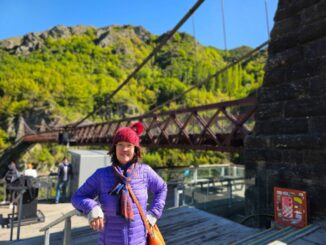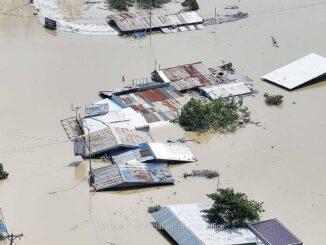
CHINA Coast Guard’s (CCG) “monster” ship is inching closer to a Philippine Coast Guard (PCG) vessel that has been maintaining its presence in Escoda (Sabina) Shoal in the West Philippine Sea for more than two months now — a move that has left authorities in Manila puzzled.
Considered the world’s largest coast guard ship, CCG 5901 is only 2,400 feet away from BRP Teresa Magbanua, PCG spokesman for West Philippine Sea Commo. Jay Tarriela said in a media forum on Saturday.
Using Canada’s Dark Vessel Detection technology, Tarriela said the PCG was able to track the movements of the 165-meter CCG ship.
He said on July 1, the ship departed from Hainan and entered the Philippines’ exclusive economic zone (EEZ) the following day.
On July 3, the vessel traveled directly to Ayungin (Second Thomas) Shoal and later proceeded to Panganiban (Mischief) Reef. After a few hours, the ship was detected heading toward Escoda (Sabina) Shoal.
“For over two consecutive days, the Chinese coast guard ship has been anchored at Escoda Shoal, maintaining a close proximity to BRP Teresa Magbanua,” said Tarriela. “Now, it is only 800 yards away from BRP Teresa Magbanua with the Chinese ship positioned on the starboard beam of the PCG vessel.”
He said the BRP Teresa Magbanua has been challenging the presence of the CCG ship through radio calls by pointing out that the place where they anchored was actually part of the Philippines’ EEZ and that they did not have jurisdiction in that area.
“We still don’t know what their intention is,” said Tarriela. “They are not responding to our question as to their intention, but what they are saying is that what they are doing is a legitimate operation since they have sovereignty over these waters.”
Magbanua also challenged the CCG vessel about launching a rigid-hull inflatable boat (RHIB).
“They just went around the vicinity of Escoda Shoal, and we told them that … we asked them about their intention of deploying a RHIB or small boat, but again, they didn’t reply to our inquiry,” Tarriela said.
So far, no harassment has been reported by PCG personnel on board the BRP Teresa Magbanua.
“Well, we can say that it’s an intimidation on the part of the CCG, but again, regardless of how many Chinese vessels they deploy there — regardless of whether it’s a People’s Liberation Army-Navy vessel, the PCG will not be intimidated or not going to pull back and direct Teresa Magbanua to go back to Palawan,” said Tarriela.
“With the clear guidance of our President (Ferdinand Marcos Jr.) and the intention of the commandant of the PCG to maintain our presence in Escoda Shoal, we’re not going to pull out, and we’re not going to be intimidated,” he said.
He said the Philippine government has always remained open in diplomacy with regard to the West Philippine Sea dispute with China.
“The mere fact that we can still engage China with Bilateral Consultation Mechanism, the mere fact that our Chinese Embassy here in Manila and we get to ask our senior diplomats to talk to them about different issues whenever we think that there is an escalation on their part — the diplomacy has always been there. We never closed our doors in diplomacy,” Tarriela said.
He also brushed aside comments made by China that the BRP Teresa Magbanua, like the BRP Sierra Madre, was a “misplaced demonstration of appreciation of things.”
“Well, first, Teresa Magbanua, that’s the flagship of the PCG, and that is the most expensive Coast Guard vessel that we have on our own inventory. Sierra Madre is an aground vessel, so whatever we do we cannot remove the ship in Ayungin. Teresa Magbanua remains to patrol and remains to be moving,” said Tarriela.
“So, regardless of whatever comments that the Chinese are saying, whether they are implying that this will just be another Sierra Madre or this is a way for us to violate anything that they say, I think we don’t have to listen to them. Again, the Teresa Magbanua’s objective is only to advance our national interest and to safeguard our position in Escoda Shoal,” he added.
‘Regressive step’
And while its “monster ship” continues its intimidation in Philippine waters, China, through its Foreign Ministry spokesman Mao Ning, called on Manila to “reconsider the US deployment of its land-based mid-range capability (MRC) missile system in the Philippines,” calling it a matter of “grave concern.”
“As we have repeatedly emphasized, this deployment is a regressive step that poses a severe threat to the security of regional countries. More importantly, it disrupts regional peace and stability and contradicts the collective aspirations of the region for peace and development,” the official said in a press briefing on Friday.
“We urgently call on the Philippines and other relevant countries to heed the voices of the region and reconsider this deployment,” the Chinese Foreign Ministry official added.
A report quoting a Philippine military official said that the US MRC missile system, capable of firing Tomahawk and SM-6 missiles, was used in recent large-scale military exercises between Filipino and American troops and was deployed in the country on April 11 this year.
The MRC system was utilized during the Army Artillery Regiment’s training on June 27 and was scheduled to be removed from the country by September, as its capability was solely used for training purposes.
Under the 2014 Enhanced Defense Cooperation Agreement (Edca), American forces have access to seven Philippine military bases in Luzon. These include Naval Base Camilo Osias in Sta. Ana, Cagayan; Lal-lo Airport in Lal-lo, Cagayan; Camp Melchor dela Cruz in Gamu, Isabela; Basa Air Base in Pampanga; Fort Magsaysay in Nueva Ecija; and Balabac Island and Antonio Bautista Air Base in Palawan.
The agreement between Manila and Washington permits the rotation of American troops for extended stays in the country. Furthermore, the United States may construct and operate facilities on local bases for both US and Philippine use.





Be the first to comment